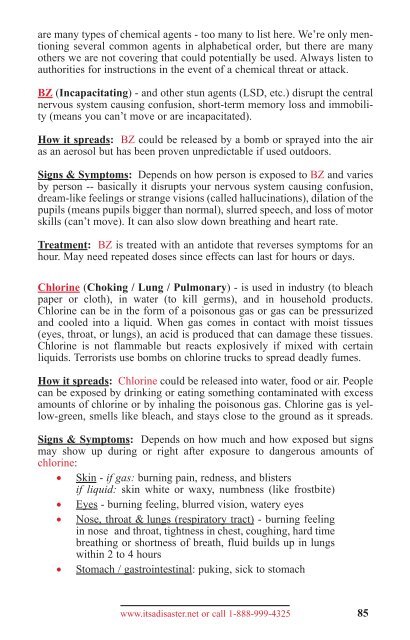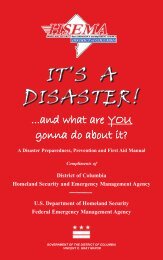disaster 5th 1108_5th ed 2011 - Homeland Security and Emergency ...
disaster 5th 1108_5th ed 2011 - Homeland Security and Emergency ...
disaster 5th 1108_5th ed 2011 - Homeland Security and Emergency ...
Create successful ePaper yourself
Turn your PDF publications into a flip-book with our unique Google optimized e-Paper software.
are many types of chemical agents - too many to list here. We’re only mentioning<br />
several common agents in alphabetical order, but there are many<br />
others we are not covering that could potentially be us<strong>ed</strong>. Always listen to<br />
authorities for instructions in the event of a chemical threat or attack.<br />
BZ (Incapacitating) - <strong>and</strong> other stun agents (LSD, etc.) disrupt the central<br />
nervous system causing confusion, short-term memory loss <strong>and</strong> immobility<br />
(means you can’t move or are incapacitat<strong>ed</strong>).<br />
How it spreads: BZ could be releas<strong>ed</strong> by a bomb or spray<strong>ed</strong> into the air<br />
as an aerosol but has been proven unpr<strong>ed</strong>ictable if us<strong>ed</strong> outdoors.<br />
Signs & Symptoms: Depends on how person is expos<strong>ed</strong> to BZ <strong>and</strong> varies<br />
by person -- basically it disrupts your nervous system causing confusion,<br />
dream-like feelings or strange visions (call<strong>ed</strong> hallucinations), dilation of the<br />
pupils (means pupils bigger than normal), slurr<strong>ed</strong> speech, <strong>and</strong> loss of motor<br />
skills (can’t move). It can also slow down breathing <strong>and</strong> heart rate.<br />
Treatment: BZ is treat<strong>ed</strong> with an antidote that reverses symptoms for an<br />
hour. May ne<strong>ed</strong> repeat<strong>ed</strong> doses since effects can last for hours or days.<br />
Chlorine (Choking / Lung / Pulmonary) - is us<strong>ed</strong> in industry (to bleach<br />
paper or cloth), in water (to kill germs), <strong>and</strong> in household products.<br />
Chlorine can be in the form of a poisonous gas or gas can be pressuriz<strong>ed</strong><br />
<strong>and</strong> cool<strong>ed</strong> into a liquid. When gas comes in contact with moist tissues<br />
(eyes, throat, or lungs), an acid is produc<strong>ed</strong> that can damage these tissues.<br />
Chlorine is not flammable but reacts explosively if mix<strong>ed</strong> with certain<br />
liquids. Terrorists use bombs on chlorine trucks to spread deadly fumes.<br />
How it spreads: Chlorine could be releas<strong>ed</strong> into water, food or air. People<br />
can be expos<strong>ed</strong> by drinking or eating something contaminat<strong>ed</strong> with excess<br />
amounts of chlorine or by inhaling the poisonous gas. Chlorine gas is yellow-green,<br />
smells like bleach, <strong>and</strong> stays close to the ground as it spreads.<br />
Signs & Symptoms: Depends on how much <strong>and</strong> how expos<strong>ed</strong> but signs<br />
may show up during or right after exposure to dangerous amounts of<br />
chlorine:<br />
• Skin - if gas: burning pain, r<strong>ed</strong>ness, <strong>and</strong> blisters<br />
if liquid: skin white or waxy, numbness (like frostbite)<br />
• Eyes - burning feeling, blurr<strong>ed</strong> vision, watery eyes<br />
• Nose, throat & lungs (respiratory tract) - burning feeling<br />
in nose <strong>and</strong> throat, tightness in chest, coughing, hard time<br />
breathing or shortness of breath, fluid builds up in lungs<br />
within 2 to 4 hours<br />
• Stomach / gastrointestinal: puking, sick to stomach<br />
www.itsa<strong>disaster</strong>.net or call 1-888-999-4325<br />
85





